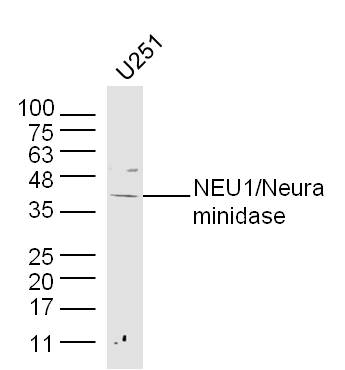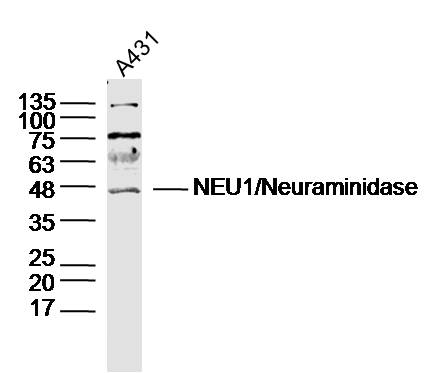
Rabbit Anti-NEU1/Neuraminidase antibody
Acetylneuraminyl hydrolase; exo-alpha-sialidase; G9 sialidase; Lysosomal sialidase; N acetyl alpha neuraminidase 1; N-acetyl-alpha-neuraminidase 1; NANH; NEU; NEU1; NEUR1_HUMAN; Neuraminidase 1; Neuraminidase; SIAL1; sialidase 1 (lysosomal sialidase); Sia
View History [Clear]
Details
Product Name NEU1/Neuraminidase Chinese Name 神经氨酸酶1抗体 Alias Acetylneuraminyl hydrolase; exo-alpha-sialidase; G9 sialidase; Lysosomal sialidase; N acetyl alpha neuraminidase 1; N-acetyl-alpha-neuraminidase 1; NANH; NEU; NEU1; NEUR1_HUMAN; Neuraminidase 1; Neuraminidase; SIAL1; sialidase 1 (lysosomal sialidase); Sialidase 1; Sialidase, lysosomal; Sialidase-1. Research Area Cell biology Developmental biology Neurobiology Signal transduction Immunogen Species Rabbit Clonality Polyclonal React Species Human, (predicted: Rat, Cow, ) Applications WB=1:500-2000 ELISA=1:5000-10000 IHC-P=1:100-500 IHC-F=1:100-500 ICC=1:100-500 IF=1:100-500 (Paraffin sections need antigen repair)
not yet tested in other applications.
optimal dilutions/concentrations should be determined by the end user.Theoretical molecular weight 45kDa Cellular localization cytoplasmic The cell membrane Form Liquid Concentration 1mg/ml immunogen KLH conjugated synthetic peptide derived from human NEU1/Neuraminidase: 151-250/415 Lsotype IgG Purification affinity purified by Protein A Buffer Solution 0.01M TBS(pH7.4) with 1% BSA, 0.03% Proclin300 and 50% Glycerol. Storage Shipped at 4℃. Store at -20 °C for one year. Avoid repeated freeze/thaw cycles. Attention This product as supplied is intended for research use only, not for use in human, therapeutic or diagnostic applications. PubMed PubMed Product Detail The protein encoded by this gene is a lysosomal enzyme that cleaves terminal sialic acid residues from substrates such as glycoproteins and glycolipids. In the lysosome, this enzyme is part of a heterotrimeric complex together with beta-galactosidase and cathepsin A (the latter is also referred to as 'protective protein'). Mutations in this gene can lead to sialidosis, a lysosomal storage disease that can be type 1 (cherry red spot-myoclonus syndrome or normosomatic type), which is late-onset, or type 2 (the dysmorphic type), which occurs at an earlier age with increased severity. [provided by RefSeq, Jul 2008]
Function:
Catalyzes the removal of sialic acid (N-acetylneuramic acid) moities from glycoproteins and glycolipids. To be active, it is strictly dependent on its presence in the multienzyme complex. Appears to have a preference for alpha 2-3 and alpha 2-6 sialyl linkage.
Subunit:
Interacts with cathepsin A (protective protein),beta-galactosidase and N-acetylgalactosamine-6-sulfate sulfatase in a multienzyme complex.
Subcellular Location:
Lysosome membrane. Lysosome lumen. Cell membrane. Cytoplasmic vesicle. Localized not only on the inner side of the lysosomal membrane and in the lysosomal lumen, but also on the plasma membrane and in intracellular vesicles.
Tissue Specificity:
Highly expressed in pancreas, followed by skeletal muscle, kidney, placenta, heart, lung and liver. Weakly expressed in brain.
Post-translational modifications:
N-glycosylated.
Phosphorylation of tyrosine within the internalization signal results in inhibition of sialidase internalization and blockage on the plasma membrane.
DISEASE:
Defects in NEU1 are the cause of sialidosis (SIALIDOSIS) [MIM:256550]. It is a lysosomal storage disease occurring as two types with various manifestations. Type 1 sialidosis (cherry red spot-myoclonus syndrome or normosomatic type) is late-onset and it is characterized by the formation of cherry red macular spots in childhood, progressive debilitating myoclonus, insiduous visual loss and rarely ataxia. The diagnosis can be confirmed by the screening of the urine for sialyloligosaccharides. Type 2 sialidosis (also known as dysmorphic type) occurs as several variants of increasing severity with earlier age of onset. It is characterized by the presence of abnormal somatic features including coarse facies and dysostosis multiplex, vertebral deformities, mental retardation, cherry-red spot/myoclonus, sialuria, cytoplasmic vacuolation of peripheral lymphocytes, bone marrow cells and conjunctival epithelial cells.
Similarity:
Belongs to the glycosyl hydrolase 33 family.
Contains 4 BNR repeats.
SWISS:
Q99519
Gene ID:
4758
Database links:
Entrez Gene: 4758 Human
Entrez Gene: 18010 Mouse
Entrez Gene: 100172668 Orangutan
Omim: 608272 Human
SwissProt: Q99519 Human
SwissProt: O35657 Mouse
SwissProt: Q5RAF4 Orangutan
Unigene: 520037 Human
Unigene: 8856 Mouse
Unigene: 128560 Rat
Product Picture
Primary: Anti-NEU1/Neuraminidase(SL8624R)at 1/300 dilution
Secondary: IRDye800CW Goat Anti-RabbitIgG at 1/20000 dilution
Predicted band size: 45kD
Observed band size: 45kD
References (0)
No References
Bought notes(bought amounts latest0)
No one bought this product
User Comment(Total0User Comment Num)
- No comment




 +86 571 56623320
+86 571 56623320
 +86 18668110335
+86 18668110335

